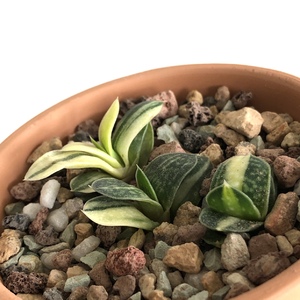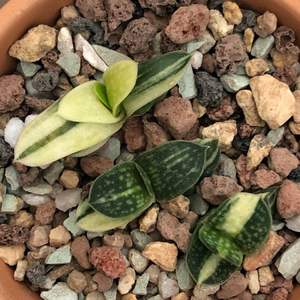植物经验
详细说明
Description: Gasteria minima, Gasteria gracilis or what else might it be called, is not currently considered a valid species. One problem with Gasteria is that there are so many hybrids between species, hybrids with Aloes and Haworthias, seedling variability, and differences between juvenile and adult plants, that it becomes almost impossible to distinguish many forms from one another. Particularly the name "gracilis" is used for wildly different forms and can cause confusion.
Rosettes: 5-7 cm in diameter; stemless with basal leaves.
Leaves: Fleshy, fat, pillowy, tongue-like. Smooth, shiny, green speckled, wide with white dots and variably striped with yellow. 3-5 cm long and 1 to 2,5 cm. wide. Distichous. Leaves may turn red if plant is stressed.
Flowers: Small up to 2 cm, pendulous, tubular, bicoloured reddish-pink and green that look like little stomachs. The inflorescence can be branched and tall.
Blooming season: Flowers can be produced any time of year, peaking in midwinter to spring.
Cultivation and Propagation: They are of easy cultivation, which makes them a good houseplant, and can be an excellent subject for the beginning gasteriaphile (it can grow easily on window sills, verandas and in miniature succulent gardens where they are happy to share their habitat with other smaller succulent plants, or in outdoor rockeries). The plant needs light shade to shade, but will take full sun part of the day. (with some sun exposure the leaf develops a nice reddish tint and remains compact) They are tolerant of a wide range of soils and habitats, but prefer a very porous potting mix to increase drainage. During the hot summer months, the soil should be kept moist but not overly wet. The plants are fertilized only once during the growing season with a balanced fertilizer diluted to ½ the recommended strength. During the winter months, water only when the soil becomes completely dry.
Propagation: Gasteria is easily propagated by the removal of offshoots or by leaf cuttings in spring or summer. To propagate by leaf cuttings, remove a leaf and let it lie for about one month, giving the wound time to heal. Then lay the leaf on its side with the basal part buried in the soil. This leaf should root within a month or two, and small plants will form at the leaf base. They can also be grown from seed.
Rosettes: 5-7 cm in diameter; stemless with basal leaves.
Leaves: Fleshy, fat, pillowy, tongue-like. Smooth, shiny, green speckled, wide with white dots and variably striped with yellow. 3-5 cm long and 1 to 2,5 cm. wide. Distichous. Leaves may turn red if plant is stressed.
Flowers: Small up to 2 cm, pendulous, tubular, bicoloured reddish-pink and green that look like little stomachs. The inflorescence can be branched and tall.
Blooming season: Flowers can be produced any time of year, peaking in midwinter to spring.
Cultivation and Propagation: They are of easy cultivation, which makes them a good houseplant, and can be an excellent subject for the beginning gasteriaphile (it can grow easily on window sills, verandas and in miniature succulent gardens where they are happy to share their habitat with other smaller succulent plants, or in outdoor rockeries). The plant needs light shade to shade, but will take full sun part of the day. (with some sun exposure the leaf develops a nice reddish tint and remains compact) They are tolerant of a wide range of soils and habitats, but prefer a very porous potting mix to increase drainage. During the hot summer months, the soil should be kept moist but not overly wet. The plants are fertilized only once during the growing season with a balanced fertilizer diluted to ½ the recommended strength. During the winter months, water only when the soil becomes completely dry.
Propagation: Gasteria is easily propagated by the removal of offshoots or by leaf cuttings in spring or summer. To propagate by leaf cuttings, remove a leaf and let it lie for about one month, giving the wound time to heal. Then lay the leaf on its side with the basal part buried in the soil. This leaf should root within a month or two, and small plants will form at the leaf base. They can also be grown from seed.
花相册 (2)


kensong
2018年10月02日

This is my first growing diary. From LS Car Ting RM6 x 3









